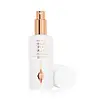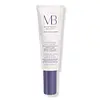What's inside
What's inside
 Key Ingredients
Key Ingredients

 Benefits
Benefits

 Concerns
Concerns

 Ingredients Side-by-side
Ingredients Side-by-side

Water
Skin ConditioningHomosalate
Skin ConditioningOctocrylene
UV AbsorberEthylhexyl Salicylate
UV AbsorberC12-15 Alkyl Benzoate
AntimicrobialButyl Methoxydibenzoylmethane
UV AbsorberButylene Glycol
HumectantCoconut Alkanes
EmollientGlycerin
HumectantSilica
AbrasiveCrambe Abyssinica Seed Oil
Skin ConditioningCetyl Alcohol
EmollientGlyceryl Stearate
EmollientCaprylyl Methicone
Skin ConditioningPotassium Cetyl Phosphate
EmulsifyingPEG-75 Stearate
Dimethyl Isosorbide
SolventPolysorbate 20
EmulsifyingPhenoxyethanol
PreservativeHydroxyacetophenone
AntioxidantMarrubium Vulgare Extract
Skin ConditioningCeteth-20
CleansingSteareth-20
CleansingCoco-Caprylate/Caprate
EmollientXanthan Gum
EmulsifyingCarbomer
Emulsion StabilisingDisodium EDTA
Rosa Damascena Extract
MaskingEthylhexylglycerin
Skin ConditioningSodium Hydroxide
BufferingBeta-Carotene
Skin ConditioningTocopherol
AntioxidantXanthophylls
Skin ConditioningMichelia Alba Leaf Oil
MaskingCitric Acid
BufferingHelianthus Annuus Seed Oil
EmollientRosmarinus Officinalis Leaf Extract
AntimicrobialSolanum Tuberosum Pulp Extract
SmoothingAcetyl Tetrapeptide-11
Skin ConditioningAcetyl Tetrapeptide-9
Skin ConditioningLinalool
PerfumingCitronellol
PerfumingGeraniol
PerfumingWater, Homosalate, Octocrylene, Ethylhexyl Salicylate, C12-15 Alkyl Benzoate, Butyl Methoxydibenzoylmethane, Butylene Glycol, Coconut Alkanes, Glycerin, Silica, Crambe Abyssinica Seed Oil, Cetyl Alcohol, Glyceryl Stearate, Caprylyl Methicone, Potassium Cetyl Phosphate, PEG-75 Stearate, Dimethyl Isosorbide, Polysorbate 20, Phenoxyethanol, Hydroxyacetophenone, Marrubium Vulgare Extract, Ceteth-20, Steareth-20, Coco-Caprylate/Caprate, Xanthan Gum, Carbomer, Disodium EDTA, Rosa Damascena Extract, Ethylhexylglycerin, Sodium Hydroxide, Beta-Carotene, Tocopherol, Xanthophylls, Michelia Alba Leaf Oil, Citric Acid, Helianthus Annuus Seed Oil, Rosmarinus Officinalis Leaf Extract, Solanum Tuberosum Pulp Extract, Acetyl Tetrapeptide-11, Acetyl Tetrapeptide-9, Linalool, Citronellol, Geraniol
Butyl Methoxydibenzoylmethane 3%
UV AbsorberHomosalate 10%
Skin ConditioningEthylhexyl Salicylate 5%
UV AbsorberBenzophenone-3 4.5%
UV AbsorberWater
Skin ConditioningC12-15 Alkyl Benzoate
AntimicrobialCyclopentasiloxane
EmollientEthylhexyl Methoxycrylene
Skin ConditioningSilica
AbrasivePropanediol
SolventPotassium Cetyl Phosphate
EmulsifyingCetearyl Alcohol
EmollientDimethicone
EmollientTocopherol
AntioxidantBuddleja Officinalis Flower Extract
UV FilterPaeonia Albiflora Root Extract
Skin ConditioningCucumis Melo Fruit Extract
Skin ConditioningHelichrysum Stoechas Extract
TonicOrchid Leaf/Root/Stem Extract
Skin ConditioningDimethicone/Vinyl Dimethicone Crosspolymer
Skin ConditioningBenzylidene Dimethoxydimethylindanone
Skin ProtectingDextran
Caprooyl Tetrapeptide-3
Skin ProtectingTribehenin PEG-20 Esters
EmollientHydrogenated Vegetable Oil
EmollientSodium Hyaluronate
HumectantButylene Glycol
HumectantPropylene Glycol
HumectantGlyceryl Stearate
EmollientPEG-100 Stearate
Glycerin
HumectantCaprylyl Glycol
EmollientPolysilicone-15
UV FilterDisodium EDTA
1,2-Hexanediol
Skin ConditioningEthylhexylglycerin
Skin ConditioningCarbomer
Emulsion StabilisingIsoceteth-10
EmulsifyingAminomethyl Propanol
BufferingPhenoxyethanol
PreservativeChlorphenesin
AntimicrobialParfum
MaskingButyl Methoxydibenzoylmethane 3%, Homosalate 10%, Ethylhexyl Salicylate 5%, Benzophenone-3 4.5%, Water, C12-15 Alkyl Benzoate, Cyclopentasiloxane, Ethylhexyl Methoxycrylene, Silica, Propanediol, Potassium Cetyl Phosphate, Cetearyl Alcohol, Dimethicone, Tocopherol, Buddleja Officinalis Flower Extract, Paeonia Albiflora Root Extract, Cucumis Melo Fruit Extract, Helichrysum Stoechas Extract, Orchid Leaf/Root/Stem Extract, Dimethicone/Vinyl Dimethicone Crosspolymer, Benzylidene Dimethoxydimethylindanone, Dextran, Caprooyl Tetrapeptide-3, Tribehenin PEG-20 Esters, Hydrogenated Vegetable Oil, Sodium Hyaluronate, Butylene Glycol, Propylene Glycol, Glyceryl Stearate, PEG-100 Stearate, Glycerin, Caprylyl Glycol, Polysilicone-15, Disodium EDTA, 1,2-Hexanediol, Ethylhexylglycerin, Carbomer, Isoceteth-10, Aminomethyl Propanol, Phenoxyethanol, Chlorphenesin, Parfum
Ingredients Explained
These ingredients are found in both products.
Ingredients higher up in an ingredient list are typically present in a larger amount.
Also known as Avobenzone, this ingredient is a chemical sunscreen filter that provides protection in the UV-A range.
Avobenzone is globally approved and is the most commonly used UV-A filter in the world.
Studies have found that avobenzone becomes ineffective when exposed to UV light (it is not photostable; meaning that it breaks down in sunlight). Because of this, formulations that include avobenzone will usually contain stabilizers such as octocrylene.
However, some modern formulations (looking at you, EU!) are able to stabilize avobenzone by coating the molecules.
Avobenzone does not protect against the UV-B range, so it's important to check that the sunscreen you're using contains other UV filters that do!
The highest concentration of avobenzone permitted is 3% in the US, and 5% in the EU.
Learn more about Butyl MethoxydibenzoylmethaneButylene Glycol (or BG) is used within cosmetic products for a few different reasons:
Overall, Butylene Glycol is a safe and well-rounded ingredient that works well with other ingredients.
Though this ingredient works well with most skin types, some people with sensitive skin may experience a reaction such as allergic rashes, closed comedones, or itchiness.
Learn more about Butylene GlycolC12-15 Alkyl Benzoate is made up of Benzoic Acid and long chain alcohols. It has a low molecular weight.
C12-15 Alkyl Benzoate is an emollient and texture enhancer. Due to its solubility, it is often used in sunscreens to help evenly distribute active ingredients.
As an emollient, C12-15 Alkyl Benzoate helps soften and hydrate your skin. Emollients create a film on your skin that traps moisture within.
This ingredient has been reported to cause eye irritation.
Learn more about C12-15 Alkyl BenzoateCarbomer is a polymer of acrylic acid. Its main role is to create a gel consistency.
A high amount of carbomer can cause pilling or balling up of products. Don't worry, most products contain 1% or less of carbomer.
Disodium EDTA plays a role in making products more stable by aiding other preservatives.
It is a chelating agent, meaning it neutralizes metal ions that may be found in a product.
Disodium EDTA is a salt of edetic acid and is found to be safe in cosmetic ingredients.
Learn more about Disodium EDTAEthylhexyl Salicylate is an organic compound used to block UV rays. It primarily absorbs UVB rays but offers a small amount of UVA protection as well.
Commonly found in sunscreens, Ethylhexyl Salicylate is created from salicylic acid and 2-ethylhexanol. You might know salicylic acid as the effective acne fighter ingredient and BHA.
The ethylhexanol in this ingredient is a fatty alcohol and helps hydrate your skin, similar to oils. It is an emollient, which means it traps moisture into the skin.
According to manufacturers, Ethylhexyl Salicylate absorbs UV wavelength of 295-315 nm, with a peak absorption at 307-310 nm. UVA rays are linked to long term skin damage, such as hyperpigmentation. UVB rays emit more energy and are capable of damaging our DNA. UVB rays cause sunburn.
Learn more about Ethylhexyl SalicylateEthylhexylglycerin (we can't pronounce this either) is commonly used as a preservative and skin softener. It is derived from glyceryl.
You might see Ethylhexylglycerin often paired with other preservatives such as phenoxyethanol. Ethylhexylglycerin has been found to increase the effectiveness of these other preservatives.
Glycerin is already naturally found in your skin. It helps moisturize and protect your skin.
A study from 2016 found glycerin to be more effective as a humectant than AHAs and hyaluronic acid.
As a humectant, it helps the skin stay hydrated by pulling moisture to your skin. The low molecular weight of glycerin allows it to pull moisture into the deeper layers of your skin.
Hydrated skin improves your skin barrier; Your skin barrier helps protect against irritants and bacteria.
Glycerin has also been found to have antimicrobial and antiviral properties. Due to these properties, glycerin is often used in wound and burn treatments.
In cosmetics, glycerin is usually derived from plants such as soybean or palm. However, it can also be sourced from animals, such as tallow or animal fat.
This ingredient is organic, colorless, odorless, and non-toxic.
Glycerin is the name for this ingredient in American English. British English uses Glycerol/Glycerine.
Learn more about GlycerinGlyceryl Stearate is a mix of glycerin and stearic acid.
It is used to stabilize the mixing of water and oil ingredients. By preventing these ingredients from separating, it can help elongate shelf life. It can also help thicken the product's texture.
As an emollient, it helps soften skin and supports barrier-replenishing ingredients.
In cosmetics, Glyceryl Stearate is often made from vegetable oils or synthetically produced.
This ingredient may not be fungal-acne safe
Fun fact: The human body also creates Glyceryl Stearate naturally.
Learn more about Glyceryl StearateHomosalate is a chemical sunscreen filter that provides protection in the UV-B range (280nm - 320 nm), with a peak protection at 306 nm. It is internationally approved for use in sunscreens.
Homosalate is not photo-stable, meaning it's strength as a UV filter degrades over time with exposure to the sun. Because of this, it's often used in combination with other chemical sunscreen filters as avobenzone (which protects from the UV-A range). Homosalate also helps act as a solvent for harder-to-dissolve UV filters.
(Part of the reason that sunscreens need to be frequently re-applied is due to the photo instability of many chemical sunscreen filters)
Currently, homosalate is approved in concentrations up to 10% in the EU and 15% in the US. The FDA is currently doing further research on the effects of homosalate, and it is possible that these approved concentrations will change in the future.
Learn more about HomosalatePhenoxyethanol is a preservative that has germicide, antimicrobial, and aromatic properties. Studies show that phenoxyethanol can prevent microbial growth. By itself, it has a scent that is similar to that of a rose.
It's often used in formulations along with Caprylyl Glycol to preserve the shelf life of products.
Potassium Cetyl Phosphate is the potassium salt of a mixture. This mixture consists of the esters from phosphoricacid and cetyl alcohol.
Potassium Cetyl Phosphate is an emulsifier and cleansing agent. Emulsifiers help stabilize a product. It does this by preventing certain ingredients from separating.
As a cleansing agent, Potassium Cetyl Phosphate helps gather oils, dirts, and pollutants from your skin. This makes it easier to rinse them away with water.
Learn more about Potassium Cetyl PhosphateSilica, also known as silicon dioxide, is a naturally occurring mineral. It is used as a fine, spherical, and porous powder in cosmetics.
Though it has exfoliant properties, the function of silica varies depending on the product.
The unique structure of silica enhances the spreadability and adds smoothness, making it a great texture enhancer.
It is also used as an active carrier, emulsifier, and mattifier due to its ability to absorb excess oil.
In some products, tiny microneedles called spicules are made from silica or hydrolyzed sponge. When you rub them in, they lightly polish away dead skin layers and enhance the penetration of active ingredients.
Learn more about SilicaTocopherol (also known as Vitamin E) is a common antioxidant used to help protect the skin from free-radicals and strengthen the skin barrier. It's also fat soluble - this means our skin is great at absorbing it.
Vitamin E also helps keep your natural skin lipids healthy. Your lipid skin barrier naturally consists of lipids, ceramides, and fatty acids. Vitamin E offers extra protection for your skin’s lipid barrier, keeping your skin healthy and nourished.
Another benefit is a bit of UV protection. Vitamin E helps reduce the damage caused by UVB rays. (It should not replace your sunscreen). Combining it with Vitamin C can decrease sunburned cells and hyperpigmentation after UV exposure.
You might have noticed Vitamin E + C often paired together. This is because it is great at stabilizing Vitamin C. Using the two together helps increase the effectiveness of both ingredients.
There are often claims that Vitamin E can reduce/prevent scarring, but these claims haven't been confirmed by scientific research.
Learn more about TocopherolWater. It's the most common cosmetic ingredient of all. You'll usually see it at the top of ingredient lists, meaning that it makes up the largest part of the product.
So why is it so popular? Water most often acts as a solvent - this means that it helps dissolve other ingredients into the formulation.
You'll also recognize water as that liquid we all need to stay alive. If you see this, drink a glass of water. Stay hydrated!
Learn more about Water